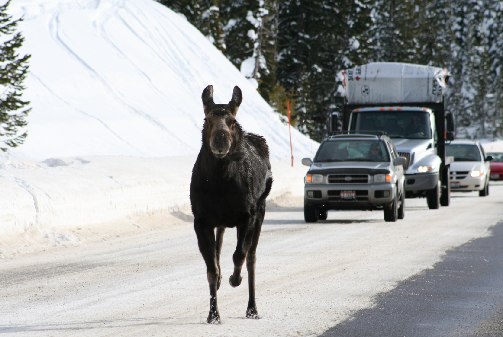Give Wildlife a Brake
Slow Down, Save Lives: Protecting Wildlife on the Move
Reducing Wildlife-Vehicle Collisions
Jackson Hole Wildlife Foundation’s “Give Wildlife a Brake” program is dedicated to reducing wildlife-vehicle collisions in the Jackson Hole area. Since its inception in 1994, the program has implemented various strategies to protect both wildlife and motorists.


Safe Driving Tips
Wild animals are killed or maimed on US roadways each year
Slow Down, Especially at Dawn and Dusk
Most wildlife is active during these low-light hours. Reducing your speed gives you more time to react.
Watch for More Than One
Animals often travel in groups. If you see one, others may be nearby or close behind.
Scan the Roadsides Continuously
Watch for movement along shoulders and in the brush—especially the glint of eyes from headlights.
Brake - Don't Swerve
Swerving can cause you to lose control or hit another vehicle. Brake firmly and stay in your lane.
Heed Wildlife Crossing Signs
These signs mark known migration routes or high-collision areas. Stay alert and slow down.
Stay Alert on Curves and Hills
Reduced visibility makes it harder to see wildlife entering the road unexpectedly.
Don't Use Cruise Control in Wildlife Zones
You need to be able to slow down quickly and respond immediately.
Key Initiatives
Public Awareness Campaigns
Educating drivers on the importance of mindful driving, especially in areas prone to wildlife crossings.
Wildlife-Vehicle Collision
Reporting on detail roadkill hotspots and trends, providing valuable data to inform mitigation efforts.
Advocacy = Wildlife Crossings
Supporting the construction of wildlife crossings, for safe wildlife movement across highways.
Roadkill Report
Our Give Wildlife a Brake and Nature Mapping programs overlap when volunteers record roadkill. These observations help us track wildlife movement and identify conflict zones across the Greater Yellowstone Ecosystem, guiding effective solutions like wildlife crossings.
Why Wildlife Crossings Matter
Wildlife Crossings: Protect the Legacy of 399
On October 22, 2024, Grizzly 399, a beloved and iconic bear, was fatally struck by a vehicle on Highway 26/89 in Snake River Canyon. At 28 years old, she was the oldest known reproducing grizzly in the Greater Yellowstone Ecosystem, renowned for raising 18 cubs and captivating wildlife enthusiasts worldwide. Her frequent presence near roads in Grand Teton National Park made her a symbol of the delicate coexistence between wildlife and humans.
The collision, deemed accidental, highlights the critical need for safer roads in wildlife corridors. Between 2009 and 2023, 49 grizzlies were killed by vehicles in the region. Grizzly 399’s death underscores the urgency of mindful driving and wildlife-friendly infrastructure to prevent future tragedies.
Let her legacy inspire action. Slow down, stay alert, and advocate for wildlife crossings to protect these magnificent creatures and their habitats. Together, we can honor her story and safeguard the future of wildlife.

Sign-Up To Receive Monthly eNews
Jackson Hole Wildlife Foundation
Tax ID # 83-0302830
Office Location:
25 S. Willow St., Suite 10
Jackson, WY 83001
Mailing Address:
PO Box 8042
Jackson, WY 83002
All rights reserved.
Privacy Policy
